As Google’s algorithms get more sophisticated, user behavior becomes more important.
This is because factors such as a short dwell time can signal to search engines that they aren’t currently ranking the best results for a particular query.
Additionally, analyzing the likes of user data can give you a unique look at how your website appears to visitors and can help you identify elements that don’t work or could use further improvement.
By taking into account how users interact with your website, you can improve not just your SEO, but your business’s online platform as a whole.
Here, I’ll cover what you can learn from:
- A high bounce rate
- A lack of conversions
- People taking little interest in your content
- Paying attention to where most of your customers are based
Read on to find out more.
High bounce rates could mean you’re targeting the wrong keywords
If you’re getting a lot of website visitors through organic search but your bounce rate is high, your web pages might not suit the intent behind your target keywords.
A lot of businesses make the mistake of simply targeting keywords with a lot of searches, but there are other factors you need to consider. The main two are searcher intent and keyword relevancy.
When you have a list of keywords that you would like to target on a particular page of your website, consider what the searcher is looking for with each term, and what type of content will best satisfy their needs.
For example, if you have a user guide that ranks for a commercial key phrase like “X product for sale,” you’d likely see a high bounce rate for that page. That’s because the content your website offers here is incompatible with the searcher’s intent behind the keyword.
However, if you change your target keyword on that page to something more relevant like “how to use X product,” that same page will probably start to receive much more engagement. And you can focus on targeting commercial keywords on the most relevant pages of your website instead.
It’s important that you pay attention to the bounce rates of different web pages, so you can assess whether your target keywords need to be tweaked. This is one way you can turn behavior data into buyer intent information.
If people don’t stay to make a purchase, improve your UX
If you’re getting a lot of website visitors, but few conversions, it could be because you’re generating top-of-the-funnel or irrelevant traffic. But one of the most common problems a lot of business owners don’t consider is that your website’s user experience might be putting people off.
You could have the best products and high-quality content, but nothing can save a website that’s hard to interact with. Plus, if your website doesn’t offer a positive UX, search engines will be hesitant to recommend it to users, which can have a negative impact on your SEO. So, pay attention to whether your customers’ behavior indicates there’s a problem.
There are a variety of UX metrics you should be tracking for your website. Generally speaking, page load speed, ease of navigation, and accessibility are important factors every website owner should take into account. If your website isn’t optimized in these areas, it could deter people from browsing for long. This can then reduce the chance of conversions, as well as make it much harder for you to climb the search engine results pages.
According to Think with Google, optimal page load time is under 3 seconds for mobile websites. That’s incredibly fast, but you can achieve it by pruning your content and compressing any images or videos.
Intuitive navigation is also helpful. If visitors don’t find what they need on the first page they click, but can easily navigate to another page on your website that better suits their interests, they may be less likely to leave right away.
To help streamline your navigation, consider creating a sitemap to help organize your website. This is a visual illustration of your website, usually in the form of a flowchart. It can help you see how all of your pages are connected and, ideally, ensure that each one is no more than two clicks away from any other.
Finally, you want your website to be accessible to as wide an audience as possible. Images should have alt text, videos should be captioned, and color should not be the only indication of emphasis or importance. It’s also worth ensuring that your content is compatible with screen readers, so those who are visually impaired can still use and enjoy your website.
By optimizing page load speed, streamlining your navigation, and making your content more accessible, you’ll surely see an improvement in your SERP rankings and a boost in sales as a result.
If no-one is reading your content, change your strategy
If people aren’t finding your content through the SERPs, clicking through from social media, or engaging with your blog, you’re probably not providing them with what they need.
Creating good content isn’t just about having the right knowledge — it’s also about how you present it.
However, deciding what types of content will best suit your customers is more complicated than you might think. To accurately predict user engagement, you have to have the right tools. Primarily by conducting keyword research, analyzing your website analytics, and researching your customers and competitors, you can come up with a content plan that will actually serve your audience.
There are certain types of content that are ideal for encouraging more engagement, targeting relevant keywords, and driving high-quality traffic to your website. Let’s take a look at what those are.
1. Free tools and resources
Consider whether you could create free tools or resources that will satisfy your ideal audience’s needs. Or, if you run an SaaS business, you could consider offering a free trial or version so people can get a feel for your product before spending money with you.
As long as these are very relevant to the type of work you do, they should help you to climb the SERPs, attract the right website visitors, and build trust with prospective customers.
Here are a couple of examples of businesses that have made free tools and resources an important (and effective) part of their SEO strategy.
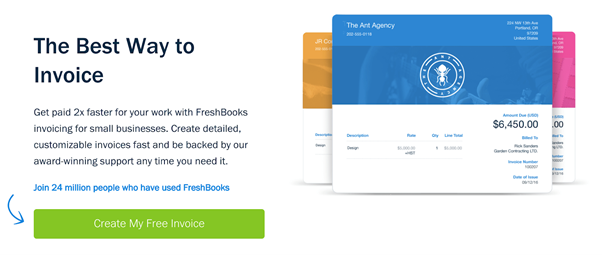
FreshBooks, an accounting software vendor, provides free invoice templates that give visitors a good idea of their expertise and build trust in their organization. Most importantly, these templates help address a huge pain point for their customer base: getting paid on time.
With a resource from FreshBooks that directly improves their day-to-day business operations, freelancers and small business owners will be much more likely to come back to FreshBooks if they need accounting help as well.
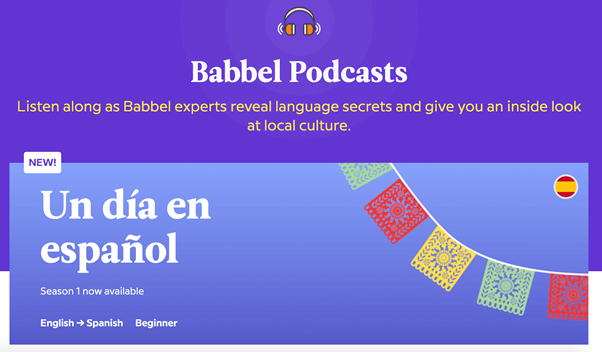
Babbel language learning software has a variety of free resources on their website in addition to their paid subscriptions. Their multilingual podcasts are a particularly helpful resource for language learners who want a regular language-learning supplement but haven’t settled on purchasing a subscription yet.
They also write a blog about language learning and cultural differences, which further demonstrates their expertise and supplements their course offerings.
2. Informative guides based on keyword research
If there are a lot of strong keywords in your niche that you don’t currently rank for, consider creating some content to specifically target those terms. A great way to do this is by writing blog posts to explain topics related to your area of expertise.
Providing a wealth of helpful information is a great way to stick out on the SERPs and, when you tailor your guides to rank for keywords related to your niche, the people you’re educating are probably going to be interested in your products or services in some capacity. Once they know your name, they’ll be more likely to come back to your business if they decide that they need your help after all.
Publishing informative content on your site can also help to boost your E-A-T. This term comes from Google’s search quality evaluator guidelines and stands for expertise, authority, and trustworthiness. Search engines only want to promote knowledgeable sources of information, so focusing on improving your E-A-T can boost your search engine rankings. And creating informative guides that you know your target audience is looking for can really help with that.
If you would like to learn more about boosting your E-A-T, make sure you check out the Search Engine Journal’s expert guide on the topic.
3. How-to guides related to your products or services
If you conduct keyword research and find that your ideal audience often researches how to carry out certain tasks related to your business or industry, catch their eye by creating tutorials.
With structured search results becoming more common, ranking well for searches like “how to do X” is also a great way to get your content to show up in Google’s rich snippets. This can help you to leapfrog the competition.
If you aren’t sure where to start with creating how-to content, let’s look at some niche examples to give you inspiration.
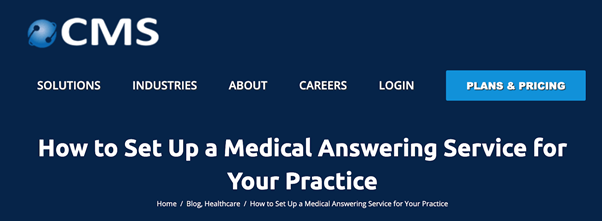
For example, Continental Message Solution is a company that specializes in helping other businesses to set up out-of-hours answering services for their phones. So, they’ve created a guide that explains how to set up an answering service for a medical practice.
This is sure to attract people who are interested in their services and builds trust by offering genuinely useful information. It also shows that the company understands this particular segment of their audience and, as a bonus, it shows that the company is an expert in its field. All of this is great for SEO, the customer experience, and boosting conversions.
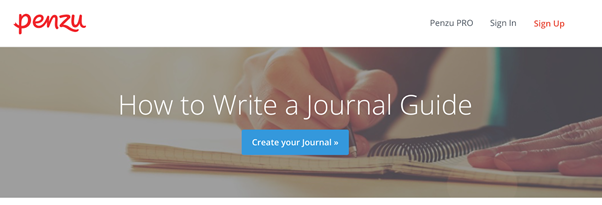
Penzu, a mobile journaling app, also has a how-to guide for teaching people how to write a journal.
In a highly digital world, journaling is sometimes considered a forgotten art. Penzu capitalizes on this fact by guiding cautious thinkers towards the ease of keeping a digital journal right on their smartphone. This is a guide that their ideal audience will find helpful, it will drive the right traffic to their website, and it gives the company a chance to promote their platform without a hard sell.
4. Buying guides or comparison pieces
If you’ve a lot of strong competitors in your field, potential customers might carry out a lot of research before deciding to pay for your products or services. You can catch them at this stage and help them through their customer journey by creating buying guides or comparison pieces that are likely to show up on the SERPs for relevant searches.
Not only will this help to direct a lot of relevant traffic to your website, but it’ll also give you the chance to show how your products or services measure up against the competition. As long as this content is fair and informative, it could help you to earn plenty of conversions.
If you aren’t sure where to start with creating a buying guide or comparison piece, let’s take a look at some effective examples.
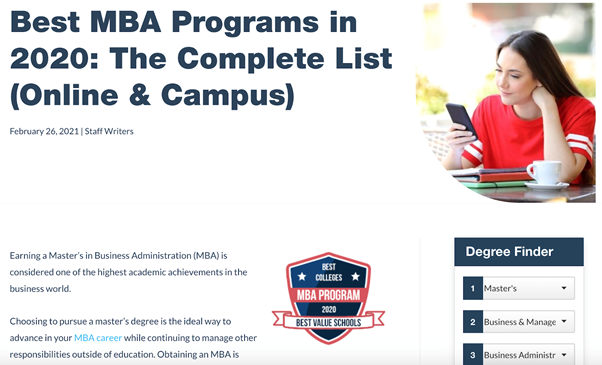
Best Value Schools is a one-stop-shop for exploring the possibilities of higher education. And, to help their website visitors choose the best institute to suit their needs, they have a huge round-up of the best MBA schools in America.
This resource provides all of the information someone might need to choose between 75 of the best schools for studying an MBA program. It outlines what each school offers, whether they have an online study option, and more.
There is also a search tool that allows visitors to look for schools based on the course they intend to study. This means, if someone can’t quite find the information they’re looking for on this page, they can look it up quickly and easily. If you offer a wide range of similar services, or you want to show how your products measure up against the competition, consider following this website’s lead and put together a comprehensive comparison guide to help your customers make the best decision for them.
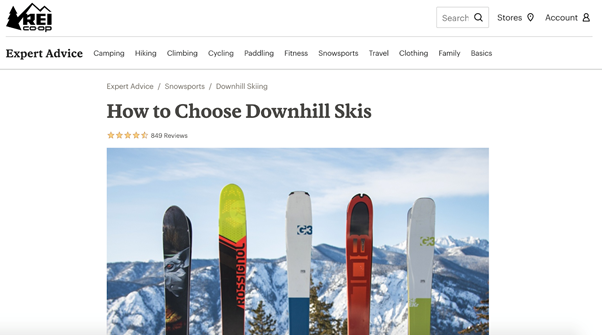
Similarly, REI apparel and outdoor gear retailer has a whole blog dedicated to their expert advice. On it, they publish a wide range of buying guides designed to help their customers purchase the right outdoor equipment. Their guide to choosing downhill skis is a great example.
Not only does this article compare the pros and cons of each option, but there are also links that allow readers to buy the ones they decide on. This makes it incredibly easy for website visitors to shift from the research stage to the buying stage.
Creating buying guides and comparison pieces is a great way to catch the eye of people who are using search engines to research their next purchase. If they end up on your website and like the sound of your products or services, they’ll be likely to check out there and then.
If your website has a lot of visitors from one area, focus on local SEO
You should be checking your website analytics on a regular basis. And, when you do, it’s worth looking into where your website visitors tend to be based. For a lot of e-commerce stores, customers can be spread far and wide. But, if you notice that a lot of your audience is concentrated in a specific area, it might be worth focusing on local SEO. This can also be a good move if you have a physical store that people can visit.
Local SEO tactics can help you to optimize your website to stand out to locals and bring new customers to your physical location.
Roadside Dental Marketing has an in-depth guide to local SEO that’s well worth checking out if you’d like to learn more about this area of digital marketing. But, basically, by optimizing your website in a specific way, you can increase the chances of your business showing up on SERPs for relevant “near me” queries. Here are some of my top tips that will help with this.
1. Target local keywords
One of the best ways to help search engines figure out your geographic location is by targeting local keywords. These will look a lot like the keywords you’re already tracking in your niche, but will also include location markers like the names of neighborhoods, cities or towns, counties, or even states and countries.
The size of the area you target will depend on the scope of your business and the popularity of your industry but, generally speaking, the main city or town you serve will be your best bet.
2. Create location pages
If your business has a physical base — and especially if it has multiple bases — you should create detailed location pages for your website.
An effective location page should have more than just your name, address, and contact information, although those should definitely be included. You also want to contextualize your location. Include an image of your building, an embedded map, and a description of prominent points of reference.
Bay Property Management Group, which rents out spaces in three American states and the US capital, optimizes its location pages for each county or neighborhood. Here is their location page for Dauphin County, PA.
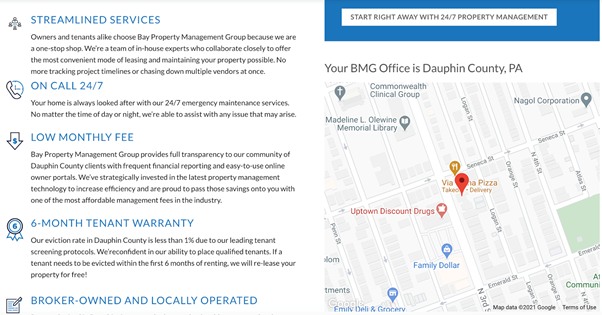
They include a rental quote, an embedded map, location and contact information, and a description of their services that are unique to the local area. This isn’t just a copy-and-paste of their other location pages — it’s uniquely tailored to this particular county. They also go above and beyond by including statistics about their local services and a profile of their local team.
When you’re creating your own location pages, it’s important that you pay this much attention to the details. The more information you include, the more context you’ll give to search engines.
3. Produce local content
Local content can also help Google locate your business and promote it to searchers in the right geographical area.
Could you write blog posts about local events that are relevant to your business, accept guest posts from other business owners in the area, or put together location-specific guides your audience will love? For example, if you own a dog groomer’s you could create a round-up of the best dog walks in the area, or if you run a hotel you could put together a tourist’s guide to the local landmarks.
The content you create should always be relevant to your business, but consider whether you could give it a local angle, too.
4. Build links on local sites
If a lot of high-quality websites are linking back to yours, this will indicate to Google that you’re a trustworthy and knowledgeable source of information. So, the search engine will give your rankings a boost.
Building local links can also help search engines to get a better idea of where your business is based. Plus, it lets you piggyback off of the local SEO work of other businesses in your area.
There are a number of ways to build local links. You could write guest posts for other businesses’ websites in your area, you could ask the local press to report on an event you’re having, or you could list your company in local directories.
Summary
By allowing user behavior data to inform your website, content, and marketing strategies, you could give your SEO a significant boost.
Optimizing your UX, targeting the right keywords, and creating content that’s immediately useful to your visitors can help boost sales for any online business. If you have a lot of local traffic or operate out of a brick-and-mortar location, consider focusing on local SEO in addition to your existing content plan.
For improved analytics and access to sophisticated website heat map data, you can request a demo of Smartlook’s services and see if they’re the right fit for your business’s needs.










